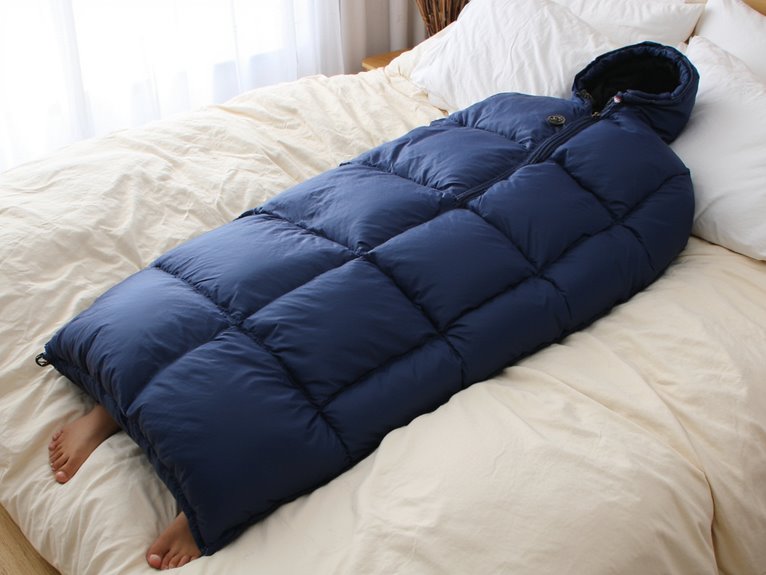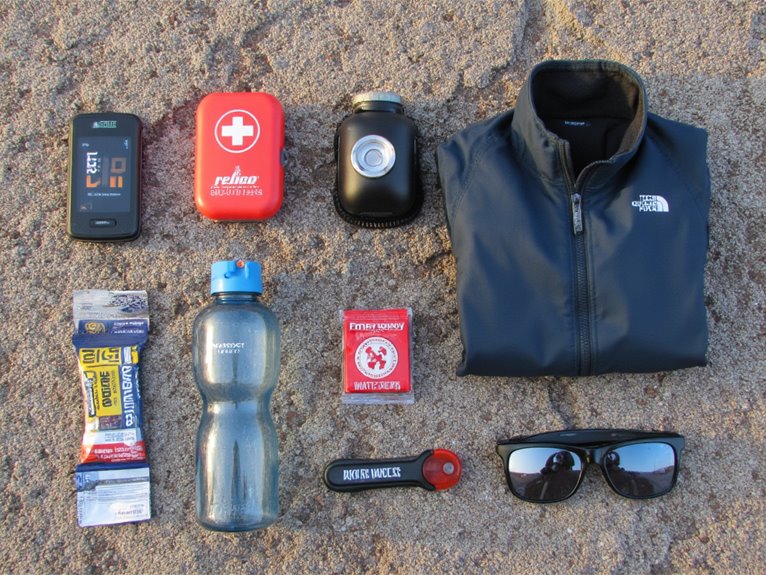Why Do You Not Wear Cotton When Hiking?
Cotton is not ideal for hiking due to its poor moisture-wicking properties, retaining water and slowing down the drying process. This leads to discomfort, fatigue, and potential skin irritation. The added weight of wet cotton affects mobility, while its slow drying properties foster bacterial growth, causing unpleasant odors. Additionally, cotton offers little wind protection, allowing cold air to penetrate and accelerate moisture evaporation. To guarantee a comfortable and safe hiking experience, it's crucial to choose fabrics that wick away moisture efficiently and dry quickly. Discover the superior alternatives that can enhance your hiking performance.
We are supported by our audience. When you purchase through links on our site, we may earn an affiliate commission, at no extra cost for you. Learn more. Last update on 16th December 2025 / Images from Amazon Product Advertising API.
Cotton Retains Moisture Poorly
Cotton's propensity to retain moisture is a significant drawback, as it can leave hikers feeling clammy and uncomfortable for extended periods. This is particularly problematic during physical activities like hiking, where excessive sweating is inevitable. When cotton absorbs moisture, it holds onto it, preventing effective evaporation and drying. As a result, hikers may experience chilling effects, even in moderate temperatures, which can lead to discomfort, fatigue, and decreased performance. In addition, moisture retention creates an ideal environment for bacterial growth, potentially causing skin irritation and infections. Moreover, the inability of cotton to manage moisture efficiently makes it an unwise choice for hiking attire, compromising both comfort and safety.
It's a Heavy Fabric Choice
When cotton absorbs moisture, its fabric weight increases, making it a heavy fabric choice for hiking. This added weight not only affects mobility but also slows down the drying process, further exacerbating the discomfort. As we examine the implications of cotton's moisture absorption, we'll discuss how this heavy fabric choice can hinder a hiker's performance.
Moisture Absorption Rate
Because cotton is a natural fiber with a high moisture absorption rate, it can become heavy and uncomfortable when wet, making it a less-than-ideal fabric choice for hiking. This means that when cotton clothing gets wet, whether from sweat or rain, it absorbs and retains a significant amount of moisture. As a result, the fabric becomes heavy, clammy, and cold, which can lead to discomfort, chafing, and even hypothermia in extreme cases. In addition, cotton's high moisture absorption rate also slows down evaporation, prolonging the wet and uncomfortable state. This characteristic makes cotton clothing unsuitable for hiking, where mobility, comfort, and dryness are essential for a safe and enjoyable experience. Additionally, this drawback is particularly problematic in outdoor activities where every ounce of energy counts.
Fabric Weight Increases
Hikers who wear cotton clothing can expect a significant increase in fabric weight as moisture is absorbed, making every step feel like a chore. This added weight is not only uncomfortable but also affects overall performance. As cotton absorbs moisture, the fabric's weight increases, leading to fatigue and discomfort. The excess weight can also cause chafing and skin irritation, additionally compromising the hiking experience. Moreover, the heavy, waterlogged fabric can restrict movement, making it more challenging to navigate challenging terrain. Choosing hiking attire that prioritizes moisture-wicking properties is crucial, allowing for a more comfortable and enjoyable hiking experience.
Slows Drying Process
Cotton's propensity to absorb moisture not only increases fabric weight but also slows the drying process, making it a heavy fabric choice for hiking. When cotton gets wet, it holds onto the moisture, taking a long time to dry. This is particularly problematic for hikers, as it can lead to discomfort, chafing, and even hypothermia in cold conditions. Additionally, slow-drying fabrics can foster the growth of bacteria and odor-causing microorganisms, making for an unpleasant hiking experience. In contrast, quick-drying fabrics like merino wool, polyester, or nylon are ideal for hiking, as they wick away moisture and dry quickly, keeping you comfortable and dry on the trail.
Slow Drying Is a Problem
When exposed to moisture, cotton fabrics tend to absorb and retain water, making them slow to dry and potentially heavy with water weight. This characteristic can be particularly problematic for hikers, as it can lead to discomfort, fatigue, and even hypothermia in extreme cases. When cotton clothing becomes saturated, it can take hours to dry, leaving the wearer feeling clammy and chilled. Additionally, the added weight of water-laden clothing can increase the energy expenditure required to hike, thereby exacerbating fatigue. By choosing alternative fabrics that dry quickly and breathe well, hikers can minimize these risks and stay comfortable and safe on the trail.
Temperature Regulation Issues Exist
Cotton clothing's slow drying properties can also disrupt the body's natural temperature regulation processes, leading to a range of undesirable consequences. When cotton absorbs moisture, it can make the body feel colder, as the moisture conducts heat away from the skin. This can lead to hypothermia in cold weather, particularly in wet conditions. In warm weather, the slow drying properties of cotton can also lead to overheating, as the body's natural cooling mechanisms are impeded. This can result in heat exhaustion or heat stroke. By wearing cotton, hikers may find themselves struggling to maintain a stable body temperature, leading to discomfort, fatigue, and potentially serious health issues.
Cotton Offers No Wind Protection
When hiking in windy conditions, cotton clothing provides little to no protection against the elements. This is because cotton fabrics are highly permeable, allowing wind to penetrate and chill the skin. As a result, hikers may experience discomfort, fatigue, and even hypothermia if not properly dressed, making wind protection a critical consideration when selecting hiking attire.
Wind Penetration Issues
Hikers who wear cotton clothing often overlook the significant impact of wind penetration on their overall comfort and safety. Cotton fabrics offer little to no resistance to wind, allowing cold air to penetrate the fabric and reach the skin. This can lead to discomfort, chill, and even hypothermia in extreme cases. Additionally, wind penetration can also accelerate moisture evaporation, leaving hikers feeling clammy and cold. In windy conditions, cotton clothing can become a liability, compromising the hiker's ability to regulate body temperature. Furthermore, by choosing wind-resistant fabrics, hikers can minimize wind penetration and maintain a comfortable body temperature, ensuring a safer and more enjoyable hiking experience.
Chilly Air Exposure
In cold and windy conditions, the lack of wind protection afforded by cotton clothing can rapidly draw heat away from the body, leaving hikers vulnerable to chilly air exposure. This is particularly problematic when hiking in mountainous or high-latitude regions, where winds can be fierce and temperatures plummet. As cotton offers no resistance to wind penetration, the body's natural heat is quickly lost, increasing the risk of hypothermia. Additionally, cotton's moisture-absorbing properties can exacerbate the issue, as it retains moisture and conducts heat away from the skin. This combination of wind exposure and moisture retention can leave hikers feeling cold, clammy, and uncomfortable, making it essential to opt for wind-resistant fabrics when venturing into harsh outdoor environments.
Fabric Porosity Problems
Cotton's porous nature renders it incapable of blocking wind, allowing chilly air to penetrate the fabric and reach the skin, thereby negating any insulation benefits. This porosity problem is exacerbated in windy or cold conditions, causing the wearer to lose heat rapidly. As a result, cotton clothing fails to provide adequate protection against the elements, leaving hikers vulnerable to hypothermia and discomfort. In addition, cotton's permeability allows moisture to penetrate the fabric, making it heavy and clammy when wet. This not only compromises thermal insulation but also increases the risk of chafing and skin irritation. When hiking, opting for wind-resistant and breathable fabrics that prioritize protection and comfort is crucial.
Better Alternatives Are Available
What options can replace cotton in a hiker's wardrobe, providing superior comfort, durability, and performance in various outdoor conditions? Fortunately, several alternatives offer improved performance. Merino wool, for instance, is an excellent choice due to its excellent moisture-wicking properties, breathability, and natural temperature regulation. Synthetic fabrics like polyester and nylon are also popular options, offering durability, quick drying, and resistance to wrinkles. Additionally, blended fabrics that combine natural and synthetic materials provide a balanced mix of comfort, durability, and performance. When selecting an alternative to cotton, consider factors such as activity level, climate, and personal preferences to choose the best option for your hiking needs.






